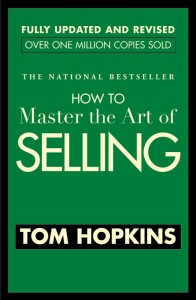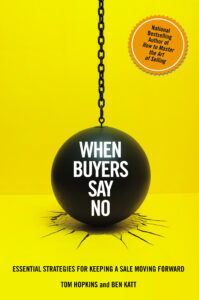Every No is One Step Closer to a Yes
When I think of overcoming objections, I immediately think about sales professionals and sales training. The fact is that sales training is a key skill for aspiring leaders whether you are in the sales profession or not.
After all, objections are not only an exercise in closing a sale. Every leader experiences rejection. If you don’t have the skills to overcome the occasional “no,” you will have difficulty leading anyone or anything.
Sales is not only closing business. It also is about selling ideas. In fact, in today’s social media age, it is often about selling yourself. Personal branding and standing out from the crowd are important skills.
 Recently, I had the opportunity to interview someone who has forgotten more about overcoming objections than I will ever know. Early in my career, I found his work to be extraordinarily helpful, and I have continued to learn from him through the years. Tom Hopkins has shared the stage with everyone from General Norman Schwarzkopf to former President George Bush and Lady Margaret Thatcher. His first book How to Master the Art of Selling has sold over 1.7 million copies. His latest book, When Buyers Say No: Essential Strategies for Keeping a Sale Moving Forward, shares his insights on rejection and the sales process.
Recently, I had the opportunity to interview someone who has forgotten more about overcoming objections than I will ever know. Early in my career, I found his work to be extraordinarily helpful, and I have continued to learn from him through the years. Tom Hopkins has shared the stage with everyone from General Norman Schwarzkopf to former President George Bush and Lady Margaret Thatcher. His first book How to Master the Art of Selling has sold over 1.7 million copies. His latest book, When Buyers Say No: Essential Strategies for Keeping a Sale Moving Forward, shares his insights on rejection and the sales process.
Understanding “No”
What’s the most common reaction to the word “no”?
Untrained sales people will mentally and emotionally give up on making the sale. They become disheartened, and it shows in their eyes and in their demeanor. They tend to avoid eye contact with the buyer because they feel personally rejected. They’ll mumble their good-byes and start thinking about where they’ll have lunch or pick up a coffee.
“No” can mean many things. Is the word “no” often misinterpreted?
In the book, When Buyers Say No, we cover seven different meanings for the word “no” in a sales situation. There’s no way for the sales person to know which one the buyer means unless they stay engaged in the sales process and ask more questions. The word “no” isn’t a stop sign. It’s more often a fork in the road. By asking the right questions about the “no,” you can determine which path to take from the point of hearing the “no.”
You say a buyer objection is a good thing. Why?
Few people will waste their time objecting to a product or service that they have no interest in. An objection is just another step in the ongoing sales process. It’s most likely to mean, “I don’t have enough information yet to make a decision.” Most objections or concerns raised by potential clients are little more than opportunities for you to understand something you missed in your qualification process or presentation.
To deal with a “no”, you offer several turnaround statements to keep the conversation going. Would you share a few examples?
The purpose of turnaround statements is to keep the conversation going after a buyer has expressed a concern or given you an objection. It’s important that you stay connected with the buyer rather than fighting their feelings about your product or service. You might say something like this:
“I understand how you feel, John. Perhaps I wasn’t clear about …” In this case, you are in essence taking the blame for the cause of his concern. You would then relay the proper information related to the concern.
Another suggestion is to say, “Obviously, you have a reason for saying that, Mary. Would you mind sharing it with me?” If you’ve established rapport and built upon it to this point in your presentation, Mary will tell you what’s behind her objection. Then you will know what you need to do or say to keep the sales process on track and moving forward.
You’ve been teaching sales techniques for decades and yet you are always coming up with new ideas. As you wrote this book, did you change your own thinking or recommended approach?
When Ben Katt approached me with his circle of persuasion, it helped me to realize a gap in my training. I had always taught sales people to expect to hear multiple no’s before they get to the yes. For that reason there are over 42 closing strategies throughout my library of training. I had previously taught a few simple strategies for what I call “bridging” between closing attempts. Ben’s diagram and methodology for keeping the sale moving forward after the first no helped me to open my mind to greater nuances that could and should be taught to create a more successful bridge.
Building Relationships
 Building rapport is important not only for a sales professional but for anyone. Would you share one way to quickly build rapport?
Building rapport is important not only for a sales professional but for anyone. Would you share one way to quickly build rapport?
Most people enjoy feeling important. First and foremost, treat them with respect and courtesy. That alone shows them that they are important to you. Then ask them open questions to get them talking. People like to talk about themselves and their loved ones or hobbies. When you get them talking, they’ll relax with you and be more open to answering the business-related questions you’ll ask as you move into your reason for contacting them.
What’s the biggest misperception about sales people?
I believe the biggest misconception about sales people is that they are pushy and untrustworthy. And that’s why I’ve dedicated my life to improving the world’s perception of people in selling. Selling isn’t about pushing at all. It’s a process of discovering people’s needs and then offering them a good solution. Ethics are always in play in sales. After qualifying your buyers and discovering their needs, if you do not have a really good solution for them, stop selling. Consider this presentation to be just part of the sales game. Offer advice as an industry expert on what may be the best solution for them. You’ll leave them without the sale but with a positive impression that should lead to them sending you referral business. You’ll keep in touch with them to ensure they get their needs handled, and ask for those referrals. After all, you did a good job for them—even if your product wasn’t right for them.
When Buyers Say No: Essential Strategies for Keeping a Sale Moving Forward

